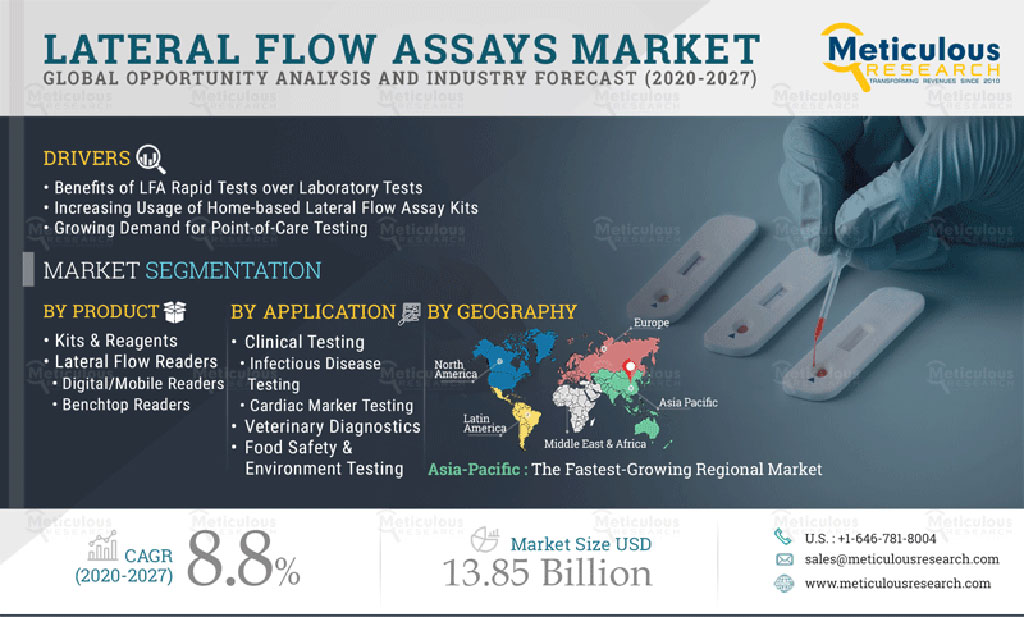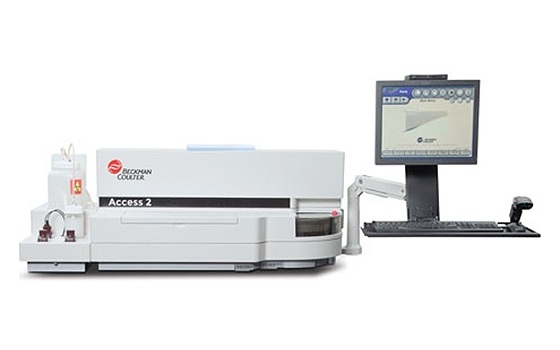Global Lateral Flow Assays Market to Reach USD 13.85 Billion by 2027 Due to Benefits of Rapid Tests and Growing Demand for POC Testing
|
By LabMedica International staff writers Posted on 20 May 2021 |

Illustration
The global lateral flow assays market is expected to grow at a CAGR of 8.8% from 2020 to 2027 to reach USD 13.85 billion by 2027, driven mainly by the benefits of LFA-based rapid tests over laboratory testing and growing demand for point-of-care testing.
These are the latest findings of Meticulous Research (Redding, CA, USA), a market intelligence provider.
Lateral flow assays are devices used to confirm the presence or absence of a target analyte without the need for lab equipment. These devices are widely used in hospitals and clinical laboratories for the qualitative and quantitative detection of specific antigens and antibodies. It is a simple and low-cost technology used in qualitative and quantitative detection of pathogens or biomarkers in humans or animals, or contaminants or toxic elements in water supplies, foodstuffs, or animal feeds.
The growth of the overall lateral flow assays market is mainly attributed to the benefits of LFA-based rapid tests over laboratory testing, increasing usage of home-based lateral flow assay kits, growing demand for point-of-care testing, increasing prevalence of chronic & infectious diseases, and growing acceptance of smart devices. In addition, evolving applications of lateral flow assays and rising demand for lateral flow assays in the food & beverage industry offer significant growth opportunities for players operating in the lateral flow assays market. On the other hand, the reluctance towards changing existing diagnostic practices and the development of multiplexing assays are some of the factors challenging the growth of this market to a certain extent. Also, variance in lateral flow assay test results and stringent regulations are expected to hinder the growth of this market.
Based on product, the kits & reagents segment accounted for the largest share of the overall lateral flow assays market in 2020, led by the higher adoption rate of kits & reagents, increasing use of home-based lateral flow assay devices, and growing demand for point-of-care testing. On the basis of technique, the sandwich assays segment accounted for the largest share of the overall lateral flow assays market in 2020, due to the wide application of sandwich assays in various medical testing settings and their advantages, such as higher sensitivity and specificity for larger analytes.
Based on application, the clinical testing segment accounted for the largest share of the overall lateral flow assays market in 2020, on the back of increasing healthcare expenditure, rising initiatives towards health awareness, growing awareness about clinical testing, and increasing spread of various chronic and infectious diseases. Based on end user, diagnostic laboratories accounted for the largest share of the overall lateral flow assays market in 2020, on account of increasing adoption of lateral flow assays due to their benefits over conventional laboratory tests, increasing use of PoC tests, growing hospital admissions, and rapid growth in demand for lateral flow tests during COVID-19. Geographically, North America accounted for the largest share of the global lateral flow assays market in 2020, followed by Europe and Asia-Pacific. The increasing prevalence of chronic and infectious diseases, rising geriatric population, growing demand for point-of-care testing facilities, and presence of key players in the region are driving the growth of the North American lateral flow assays market.
Related Links:
Meticulous Research
These are the latest findings of Meticulous Research (Redding, CA, USA), a market intelligence provider.
Lateral flow assays are devices used to confirm the presence or absence of a target analyte without the need for lab equipment. These devices are widely used in hospitals and clinical laboratories for the qualitative and quantitative detection of specific antigens and antibodies. It is a simple and low-cost technology used in qualitative and quantitative detection of pathogens or biomarkers in humans or animals, or contaminants or toxic elements in water supplies, foodstuffs, or animal feeds.
The growth of the overall lateral flow assays market is mainly attributed to the benefits of LFA-based rapid tests over laboratory testing, increasing usage of home-based lateral flow assay kits, growing demand for point-of-care testing, increasing prevalence of chronic & infectious diseases, and growing acceptance of smart devices. In addition, evolving applications of lateral flow assays and rising demand for lateral flow assays in the food & beverage industry offer significant growth opportunities for players operating in the lateral flow assays market. On the other hand, the reluctance towards changing existing diagnostic practices and the development of multiplexing assays are some of the factors challenging the growth of this market to a certain extent. Also, variance in lateral flow assay test results and stringent regulations are expected to hinder the growth of this market.
Based on product, the kits & reagents segment accounted for the largest share of the overall lateral flow assays market in 2020, led by the higher adoption rate of kits & reagents, increasing use of home-based lateral flow assay devices, and growing demand for point-of-care testing. On the basis of technique, the sandwich assays segment accounted for the largest share of the overall lateral flow assays market in 2020, due to the wide application of sandwich assays in various medical testing settings and their advantages, such as higher sensitivity and specificity for larger analytes.
Based on application, the clinical testing segment accounted for the largest share of the overall lateral flow assays market in 2020, on the back of increasing healthcare expenditure, rising initiatives towards health awareness, growing awareness about clinical testing, and increasing spread of various chronic and infectious diseases. Based on end user, diagnostic laboratories accounted for the largest share of the overall lateral flow assays market in 2020, on account of increasing adoption of lateral flow assays due to their benefits over conventional laboratory tests, increasing use of PoC tests, growing hospital admissions, and rapid growth in demand for lateral flow tests during COVID-19. Geographically, North America accounted for the largest share of the global lateral flow assays market in 2020, followed by Europe and Asia-Pacific. The increasing prevalence of chronic and infectious diseases, rising geriatric population, growing demand for point-of-care testing facilities, and presence of key players in the region are driving the growth of the North American lateral flow assays market.
Related Links:
Meticulous Research
Latest Industry News
- VedaBio Partners With Mammoth Biosciences to Expand CRISPR-Based Diagnostic Technologies
- Werfen and VolitionRx Partner to Advance Diagnostic Testing for Antiphospholipid Syndrome
- Siemens Healthineers and Carna Health Partner to Advance Kidney Care Innovation
- Vircell Launches New Website for Molecular Control Products
- Tempus AI Acquires Digital Pathology Company Paige
- New Manual to Help Clinicians Better Diagnose and Treat Infection-Associated Chronic Illness
- WHO Releases Updated Guidance on Tuberculosis Diagnosis
- Pioneering Collaboration to Transform Pediatric Cancer Diagnostics and Research
- Bio-Techne Divests Exosome Diagnostics to Reposition Product Portfolio
- New Clinical Guidelines Recommend Use of Blood Tests Instead of Brain Scans for Alzheimer’s Diagnosis
- IFCC WorldLab 2026 To Be Held in India on October 25-29
- PHASE Scientific and Lumos Diagnostics Partner on Rapid POC Test for Bacterial Respiratory Infection
- QuidelOrtho and BÜHLMANN Collaborate on Gastrointestinal Biomarker Tests
- BD Biosciences & Diagnostic Solutions to Merge with Waters
- 2025 COMPAMED Innovation Forum Highlights Pioneering Work in Cancer Diagnostics
- Quanterix Completes Acquisition of Akoya Biosciences
Channels
Clinical Chemistry
view channel
Gold Nanoparticles to Improve Accuracy of Ovarian Cancer Diagnosis
Ovarian cancer is considered one of the deadliest cancers, in part because it rarely shows clear symptoms in its early stages, and diagnosis is often complex. Current approaches make it difficult to accurately... Read more
Simultaneous Cell Isolation Technology Improves Cancer Diagnostic Accuracy
Accurate cancer diagnosis remains a challenge, as liquid biopsy techniques often fail to capture the complexity of tumor biology. Traditional systems for isolating circulating tumor cells (CTCs) vary in... Read moreMolecular Diagnostics
view channel
2-Hour Cancer Blood Test to Transform Tumor Detection
Glioblastoma and other aggressive cancers remain difficult to control largely because tumors can recur after treatment. Current diagnostic methods, such as invasive biopsies or expensive liquid biopsies,... Read more
Automated High Throughput Immunoassay Test to Advance Neurodegenerative Clinical Research
Alzheimer’s disease and other neurodegenerative disorders remain difficult to diagnose and monitor accurately due to limitations in existing biomarkers. Traditional tau and phosphorylated tau measurements... Read more
Ultrasensitive Test Could Identify Earliest Molecular Signs of Metastatic Relapse in Breast Cancer Patients
HR+ (hormone receptor-positive) HER2- (human epidermal growth factor receptor 2-negative) breast cancer represents over 70% of all breast cancer cases and carries a significant risk of late recurrence.... Read moreHematology
view channel
Pioneering Model Measures Radiation Exposure in Blood for Precise Cancer Treatments
Scientists have long focused on protecting organs near tumors during radiotherapy, but blood — a vital, circulating tissue — has largely been excluded from dose calculations. Each blood cell passing through... Read more
Platelets Could Improve Early and Minimally Invasive Detection of Cancer
Platelets are widely recognized for their role in blood clotting and scab formation, but they also play a crucial role in immune defense by detecting pathogens and recruiting immune cells.... Read more
Portable and Disposable Device Obtains Platelet-Rich Plasma Without Complex Equipment
Platelet-rich plasma (PRP) plays a crucial role in regenerative medicine due to its ability to accelerate healing and repair tissue. However, obtaining PRP traditionally requires expensive centrifugation... Read moreImmunology
view channel
Novel Tool Uses Deep Learning for Precision Cancer Therapy
Nearly 50 new cancer therapies are approved each year, but selecting the right one for patients with highly individual tumor characteristics remains a major challenge. Physicians struggle to navigate the... Read more
Companion Diagnostic Test Identifies HER2-Ultralow Breast Cancer and Biliary Tract Cancer Patients
Breast cancer is the most common cancer in Europe, with more than 564,000 new cases and 145,000 deaths annually. Metastatic breast cancer is rising in younger populations and remains the leading cause... Read moreMicrobiology
view channel
Microfluidic Platform Assesses Neutrophil Function in Sepsis Patients
Sepsis arises from infection and immune dysregulation, with neutrophils playing a central role in its progression. However, current clinical tools are unable to both isolate these cells and assess their... Read moreNew Diagnostic Method Confirms Sepsis Infections Earlier
Sepsis remains one of the most dangerous medical emergencies, often progressing rapidly and becoming fatal without timely intervention. Each hour of delayed treatment in septic shock reduces patient survival... Read more
New Markers Could Predict Risk of Severe Chlamydia Infection
Chlamydia trachomatis is a common sexually transmitted infection that can cause pelvic inflammatory disease, infertility, and other reproductive complications when it spreads to the upper genital tract.... Read more
Portable Spectroscopy Rapidly and Noninvasively Detects Bacterial Species in Vaginal Fluid
Vaginal health depends on maintaining a balanced microbiome, particularly certain Lactobacillus species. Disruption of this balance, known as dysbiosis, can increase risks of infection, pregnancy complications,... Read morePathology
view channelAccurate Pathological Analysis Improves Treatment Outcomes for Adult Fibrosarcoma
Adult fibrosarcoma is a rare and highly aggressive malignancy that develops in connective tissue and often affects the limbs, trunk, or head and neck region. Diagnosis is complex because tumors can mimic... Read more
Clinicopathologic Study Supports Exclusion of Cervical Serous Carcinoma from WHO Classification
High-grade serous carcinoma is a rare diagnosis in cervical biopsies and can be difficult to distinguish from other tumor types. Cervical serous carcinoma is no longer recognized as a primary cervical... Read moreTechnology
view channel
Coral-Inspired Capsule Samples Hidden Bacteria from Small Intestine
The gut microbiome has been linked to conditions ranging from immune disorders to mental health, yet conventional stool tests often fail to capture bacterial populations in the small intestine.... Read more




















